Ever since I set up an e-mail alert for the phrase, “Manhattan Project,”1 I’ve been getting an interesting cross-section of discussions on the Internet about the history of the atomic bomb.
One of the interesting ones to pop up again and again is the question of whether the United States warned Hiroshima and Nagasaki about their impending destruction. It’s a discussion in this case that has actually been confused by the abundance of context-less primary sources on the Internet. In particular, the Truman Library posted (some time back) copies of leaflets that it has labeled as being dropped on August 6, 1945 — the day of the Hiroshima bombing. These leaflets have proliferated across the web onto other reputable sites, like PBS’s Truman resources. The understandable result is that a lot of amateur historians out there have concluded that indeed, we did warn the Japanese.
But the truth, as with many things, is more complicated. I want to talk about three potential “warnings,” here, as both a means to help clarify this issue (to any other future Googlers about this topic), and also to use it as a case study for why history is more than just finding documents.
The first potential “warning” is the Potsdam Declaration. It was issued on July 26, 1945, by Truman, Churchill, and Chiang Kai-shek. It ends with this particular bit:
“We call upon the government of Japan to proclaim now the unconditional surrender of all Japanese armed forces, and to provide proper and adequate assurances of their good faith in such action. The alternative for Japan is prompt and utter destruction.”
Was the “prompt and utter destruction” meant to imply atomic bombing? It’s not clear. An earlier draft of the statement, written by Secretary of War Stimson and his staff well before the results of the Trinity test were known, doesn’t include the “prompt and utter destruction” phrase. It does, however, emphasize that the point of the Potsdam Declaration is to try and shake Japan into surrendering, and that part of how it should do so is to outline “The varied and overwhelming character of the force we are about to bring to bear on the islands,” and “The inevitability and completeness of the destruction which the full application of this force will entail.” Varied and overwhelming sound like Stimson was thinking about more than just atomic bombs — he’s thinking about further firebombing, he’s thinking about invasion.
In any case, a veiled warning is not much of a warning. I’m not saying that the Potsdam Declaration should have warned specifically about atomic bombs — whether that would have done anything positive is unclear to me — but I think under any reasonable interpretation, it isn’t possible except in retrospect to even imply that it was some kind of warning about atomic bombs.
The second potential “warning”: the so-called LeMay leaflets. These were leaflets that were dropped on dozens of Japanese cities in July 1945. There were many versions of the leaflets dropped. Some listed specific cities, some did not. The most famous one, shown above, depicts a squadron of B-29s laying waste to a city with firebombs. The text apparently (I don’t read Japanese) said the following:
Read this carefully as it may save your life or the life of a relative or a friend. In the next few days, four or more of the cities named on the reverse side of this leaflet will be destroyed by American bombs. These cities contain military installations and workshops or factories, which produce military goods. We are determined to destroy all of the tools of the military clique that they are using to prolong this useless war. Unfortunately, bombs have no eyes. So, in accordance with America’s well-known humanitarian policies, the American Air Force, which does not wish to injure innocent people, now gives you warning to evacuate the cities named and save your lives.
America is not fighting the Japanese people but is fighting the military clique, which has enslaved the Japanese people. The peace, which America will bring, will free the people from the oppression of the Japanese military clique and mean the emergence of a new and better Japan.
You can restore peace by demanding new and better leaders who will end the War.
We cannot promise that only these cities will be among those attacked, but at least four will be, so heed this warning and evacuate these cities immediately.
Which cities were warned? I’ve seen sources that basically say, following an article in the CIA’s Studies in Intelligence, that they were “delivered to Hiroshima, Nagasaki, and 33 other Japanese cities on 1 August 1945.” Curiously, this phrase has been removed in their main web version of the document. I’d love to see the actual list of cities that they were delivered to, if someone has it, or can translate it. Specifically, I’m curious if all four of the final atomic bomb targets (Hiroshima, Kokura, Nagasaki, and Nigata) were on the list or not, since the US Army Air Forces had agreed to “preserve” those targets from firebombing. (I’d also be interested in knowing if Kyoto was named or not.)
These leaflets certainly warned of bombing and destruction. They were not warnings about atomic bombs, though, but firebombs. Does the distinction matter? I’ll come to that at the end. They are, if anything, the closest thing to any kind of “real warning” that was given to Japanese civilians.
Lastly, we have those mysterious warnings from the Truman website, the ones which were very specific about atomic bombs. There are reasons on the face of it to be suspicious that it is what the Truman Library claims it is.
The first one is dated by the library to August 6th, 1945. The fact that it references the past destruction of Hiroshima makes it, of course, pretty clear that it wasn’t dropped on Hiroshima ahead of time, and throws the dating into question — even if it was drawn up on August 6th, it’s too late to be used on Hiroshima. A second one, also labeled as August 6, 1945, references the Soviet invasion of Manchuria… which took place on August 9th. So, just a priori, we can’t really give the library’s own dating labels any credence — they’re clearly wrong about the dates, and the dates matter in this case, since we are talking about whether the warnings happened before the bombs were actually used. And that’s not even getting into the whole “the atomic bomb was a secret” bit.
What’s going on here? There’s only so much we can learn from these two isolated documents alone. For more… we head into the archives!
In late May 1946, Lt. Colonel J.F. Moynahan wrote a memo to General Groves with the subject heading “History Psychological Warfare, Manhattan Project.”2 It appears Groves wanted it for his internal “Manhattan District History” he was compiling (more on that another time). I’ve included the entire memo above, so you can read it at your leisure, but here’s the main timeline that Moynahan lays out.
On August 7th, 1945 — the day after Hiroshima — General Henry “Hap” Arnold ordered that propaganda leaflets be prepared regarding the atomic bomb. General Thomas Farrell, Groves’ representative in the Pacific, was charged with carrying it out. This is interesting, no? It was the Army that made the call, not the Manhattan Project people.
The Army Air Forces were instructed to lend their assistance. Farrell received the cable as he was boarding a C-54 plane (along with, among others, Enola Gay pilot Paul Tibbets) to visit Admiral Nimitz to report on the Hiroshima mission. Farrell set the ball in motion by getting in touch with the propaganda people already in the Pacific, and work began on planning the leaflet missions on Saipan. It was determined that they should use “half-sized” leaflets, and that they should try to distribute 6 million of them. They also made an inventory of the “leaflet bombs” that they were dropped out of the planes in (you don’t just drop them out of the hatch). They decided, in terms of targeting, to try and get a 60% saturation of all 47 enemy cities that had a population of over 100,000.
Then they had to figure out the text of it. Drafts were drawn up. Work was hurried. They worked straight through the night of August 7th. The Manhattan Project personnel on Tinian were intensely interested, as you’d expect, to the degree that they were “at times a positive obstruction” to finishing the drafts.
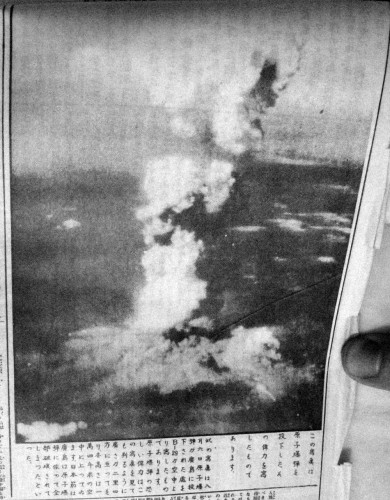
A copy of the final “atomic bomb” leaflet, I think? I don’t read Japanese, but this was attached to the above memo. If you do read Japanese, I’d love a translation. Please ignore my thumb in the corner — it’s hard to photograph documents that are bound like these ones were.
Finally, on the morning of August 8th, the plan was presented to Farrell at Tinian. Farrell edited the message a bit and approved it. The message was then flown to Guam, where the Army Air Forces and the Navy signed off on it. Radio Saipan was told to broadcast the message every 15 minutes, though Moynahan had no information as to when that actually began. The translation of the text was done, fascinatingly enough, by three Japanese officers held as prisoners on Guam. After talking with the officers, the Americans also decided to make the format look like that of a Japanese newspaper.
What they still lacked were the leaflet bombs — they had run low. A midnight flight from Sapian to Guam supplied those. And then Russia entered the war. So it was decided that they should incorporate that into the message. So that slowed things up again. Finally, they got it ready to go… but they weren’t in any way coordinated with the actual bombing plans. So Nagasaki did get warning leaflets… the day after it was atomic bombed.
Well, that’s a grim clarification. The short version: leaflets specifically warning about atomic bombs were created… but they weren’t dropped on either Hiroshima or Nagasaki before they were atomic bombed. The first Truman Library document was the first draft, that was never dropped. The second one was the second draft, and was dropped, but only after the bombs were used.
So what do we take away from all of this? The first is the historian’s point: isolated, context-free documents do not interpret themselves. Part the hard job of an historian is to provide the context for a given historical artifact. In this case, we’re talking about leaflet drafts, and the context is when they created, why they were created, and specifically when they were used. It doesn’t help, of course, that the library themselves have put incorrect dates on them, but even with a correct date, the context is still not completely straightforward. Context is everything — without it, nothing makes sense, and you can come away with exactly the opposite conclusion from the truth of things.
The second question is about the warnings themselves. I don’t think the Potsdam statement counts as a real warning — it’s an ultimatum, and it’s a vague one. I don’t think the atomic bombing leaflets count as real warnings, either — they were dropped after the fact.
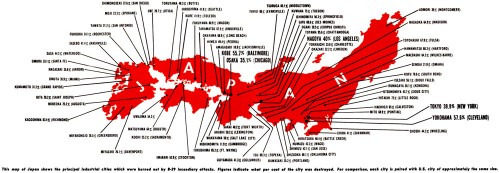
A map created by the US Army Air Forces in the immediate postwar showing their strategic bombing handiwork. Includes percentages of cities destroyed, as well as similar-sized American analogs. Cleaned up by me from the original.
But the LeMay leaflets are the more complicated case. They are ostensibly warnings of immediate destruction — and the cities they “warned” were indeed destroyed, famously so. Whether they warned of destruction by firebombing or atomic bombing strikes me as somewhat of a distinction without a difference. Either way, it’s destruction of entire cities.
But do the leaflets in any way reduce culpability, for either the firebombs or the atomic bombs? This is the more difficult moral question. The leaflets were written as if they were dropped because the American Air Force actually cared about civilian lives:
Unfortunately, bombs have no eyes. So, in accordance with America’s well-known humanitarian policies, the American Air Force, which does not wish to injure innocent people, now gives you warning to evacuate the cities named and save your lives.
This strikes me as pure falsehood. The entire goal of the strategic bombing was to destroy civilian cities, with the idea of breaking the Japanese ability to make any kind of war, and with breaking the Japanese spirit. The firebombing raids had been optimized for the maximum destruction of entire cities, not just the parts involved with actual warmaking or even periphery industries. The “shock” effect of the atomic bombs was in part predicated on them taking high numbers of lives — they were meant to be so horrible as to be unendurable. The idea that firebombing was somehow, in any fashion, meant to be compatible with “humanitarian policies” is complete nonsense.
The leaflets were not part of any humanitarian mission. They were part of a campaign of “Psychological Warfare,” as was very explicit within their organization in the military. The goal was to convince the Japanese people to rebel, or to abandon their posts, or to hide, or to pressure their leaders into surrender. Now, whether that is ultimately, in a means-to-an-end way, “humanitarian” or not, one can debate. But you have to get pretty far along that twisty road to think that burning civilians alive is “humanitarian.”
Here’s a thought experiment: If a terrorist sent a warning before nuking an American city, would that get them off the hook for the bombing? (Much less if they named three possible cities, and then only bombed one of them.) If Hitler had issued an ultimatum to Great Britain that surrender was the only option, would he be let off the hook for the Blitz? Does it matter that the “warnings” in question were issued to a very non-free Japanese populace?
Ultimately what I’m asking is, do warnings really matter? I don’t think there’s an easy, pat answer here. There are a lot of interlocked ethical questions about ends-versus-means, the obligation of an attacking power, the obligation of a citizen in a country during war, and so on. Personally, though, I do think it’s somewhat of a red herring: the real issue still, for me, is under what circumstances one accepts the morality of total war. Because if you haven’t hashed that out, then quibbling about which warning was specific enough, whether that somehow reduced moral culpability, is all just an issue of counting angels on the head of a pin.
- I used to do this with Google Alerts, but their service has been fickle as of late, so I’ve also signed up with Talkwalker. [↩]
- Citation: Lt. Col. J.F. Moynahan to General Leslie R. Groves, “History Psychological Warfare, Manhattan Project,” (23 May 1946), National Archives and Records Administration, College Park, MD, RG 77, Box 49, “314.7 – History (MED).” [↩]
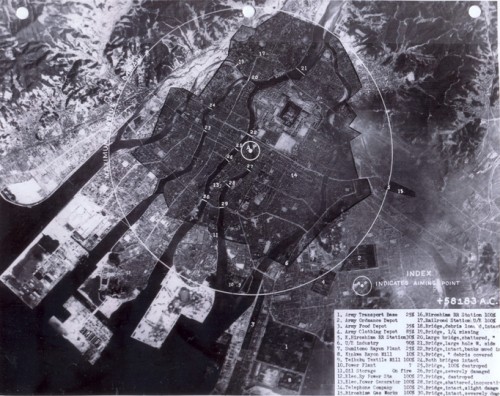
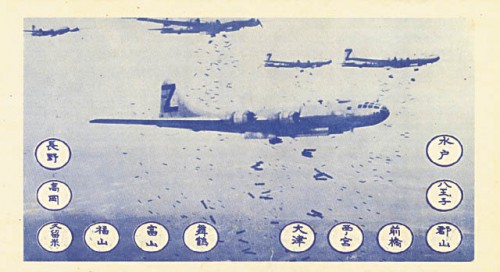
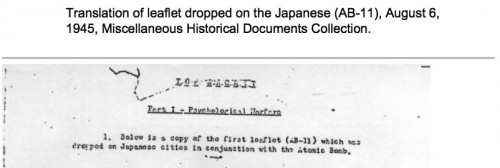
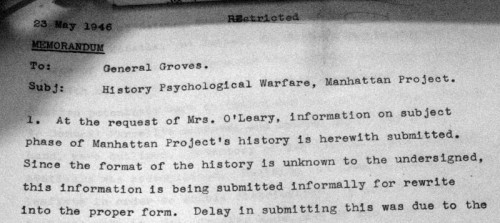
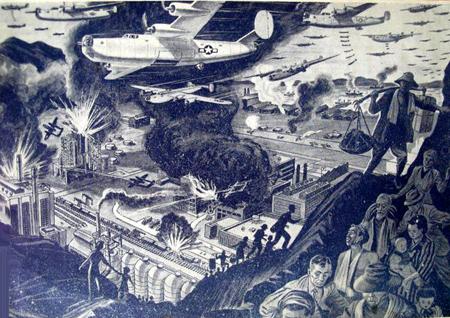



Alex-
Part of the myth of “warning” also can be traced to the 1946 film The Beginning or the End in which it’s implied that the Japanese were warned.
P.
From what I can read, none of the 4 target cities (Hiroshima, Kokura, Nagasaki, and Nigata) are included in the image on the bomblet that you showed.
The LeMay leaflets may have been designed to increase the ‘effectiveness’ of the campaign. After all, if a large scale abandonment of the war factories could be also achieved, it would have a multiplier effect.
The atomic bomb leaflet also probably was designed to increase the effectiveness of the atomic bombs. At the time, and for many years later; our capabilities was a highly guarded secret. The goal may have been to re-enforce the idea that the atomic bombs will continue if they do not surrender immediately.
In any event, I consider the issue of ‘warning’ to be mostly immaterial to the question on the ethics and morality of the bombings themselves. To me, they were just another tool utalized to obtain unconditional surrender.
I wonder if the Japanese interpreted the “prompt and utter destruction” any differently from the pounding which they had gotten during the previous six months from strategic bombing.
[…] week I went over, in painful detail, the question of whether leaflets had been dropped on Hiroshima or Nagasaki warning them about bombing, atomic or otherwise. Some of the information was in Japanese, which is not one of my languages […]
What has always ‘got’ me is the fact they could have displayed their might by dropping the bomb on a non populated area and then stating the fact that if Japan did not surrender unconditionally the next would be dropped on a populated city? Surely this would have created the same response? and lessened the needless death and destruction that ensued?. Sadly there is no real moral high ground in war, but a little more thought and America could have had it in this instance along with victory! albeit with a rather large crator somewhere in rural Japan.
I would say that hypothesis is flawed in that the terror of nuclear weapons comes precisely from the fact that it can kill so many and destroy so much. Throwing the bomb in the middle of nowhere would not demonstrate anything and nobody would be around to see or experience it. It also still gives validity to the supposed moral fairness of the “warning”.
There is no “needless” death and destruction in total war. You win by killing as many people and destroying as much infrastructure as possible or by killing everyone and destroying everything—the sooner the better.
You speak of victory. Who wins when the argument comes down to “Surrender or we kill your whole country” versus “We will sacrifice every man, woman, and child in our last stand”?
A but late, but I remembered I had a photo of one of the Day After leaflets from the Bradbury museum in Los Alamos
http://www.flickr.com/photos/rocbolt/8061641195/in/set-72157631709639666
Interesting — am I correct in thinking that they don’t really clarify when they were dropped, as oppose to when they were written?
Also — nice photographs!
I guess the caption does leave that ambiguous, as if they started the effort the day after and not necessarily dropped them the day after.
There’s certainly plenty of photos up there! Getting them all titled and captioned is an ongoing process but I try to get as much from museums and historical sites up as I can in the hope that it’ll be useful to someone else someday
A bit late, but the full list of cities on the pamphlet from the image above are, from upper left to upper right: Nagano, Takaoka, Kurume, Fukuyama, Toyama, Maizuru, Otsu, Nishinomiya, Maebashi, Koriyama, Hachioji, and Mito. The four cities considered to be nuked were not on there.
Upper left first circle is Nagasaki. Niigata, Hiroshima, and Kokura not named. I am resident Japan, graduate of Komazawa Daigaku, now 71 years old, was 2 years age in Hiroshima day of genshi bakudan.. What happened happened, warning or no. Both governments to blame, men of reason did not prevail and innocent died because of few politicians and irrational ideologies.. The circle of insanity persists to this day.
有難う
[…] with the question of whether a “demonstration” should be made, for example, or whether Japan should be given a direct warning first), and he chose one apparently under false […]
[It’s a pleasure to find a website where this issue can be discussed with the truth of the matter is given greater emphasis than self-justifications.]
Observations:
(1) The horrible irony of Farrell leaflets being dropped on the smoldering ruins of Nagasaki. (I trust they were not dropped on Hiroshima!)
(2) The Le May leaflet came months after some of the worst firebombing, for example Tokyo in March.
(3) “Psychological Warfare” says it all. The intent was to get a multiplier effect, disrupt life even in cities that were not targeted.
(4) The fact that Hiroshima, Kukouro, and Niigata were NOT on the Le May list, can be explained by the fact that they were not being targeted for conventional (friebombing!). To list them and to continue to not bomb them would diminish the credibility of the leaflet. (For this reason, I suspect Nagasaki was not on the list, as dk says, as opposed to what Hiiyoku says. Let’s get an informed third opinion.)
(4) It is not credible to expect 12 cities to evacuate in three days (the pace of atomic pombing apparent to Japanese aware of H&N).
(5) The Le May leaflet, if followed, would have depopulated Japanese cities. How would all these homeless people have survived? Perhaps this had something to do with the fact that no one took them seriously.
Speculation:
(a) The motive for writing the Farrell leaflet was not to warn Nagasaki but for the multiplier effect. Even if it had been dropped on 8 August, is two days enough time to evacuate an entire city?
(b) Could part of the motive have been to ‘cover their asses’? If so, even this was SNAFUed.
I think laying the blame at the foor of total war is correct. This is a satanic concept and nuclear weapons are just a spawn of this devil. War must respect cities, not treat them as fair game.
[…] but then, at least, you can say you showed them what was coming first. As it was, we gave no real warning whatsoever before dropping it on Hiroshima. But here’s the question I come to next: could you […]